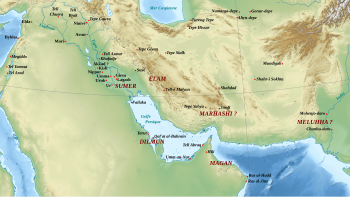
Back ድልሙን Amharic دلمون Arabic دلمون ARZ Дыльмун Byelorussian Дилмун Bulgarian Dilmun Catalan Dilmun Czech Dilmun Danish Dilmun German Dilmun Esperanto
 | |
| Location | Eastern Arabia |
|---|---|
| Region | Northern Governorate |
| Type | Ancient |
| Part of | Eastern Arabia |
| History | |
| Founded | c. late 4th millennium BC[1] |
| Abandoned | c. 538 BC[2] |
| Periods | Bronze Age |
Dilmun, or Telmun,[3] (Sumerian: ![]() ,[4][5] later 𒉌𒌇(𒆠), ni.tukki = DILMUNki; Arabic: دلمون) was an ancient East Semitic-speaking civilization in Eastern Arabia mentioned from the 3rd millennium BC onwards.[6][7]
Based on contextual evidence, it was located in the Persian Gulf, on a trade route between Mesopotamia and the Indus Valley civilisation, close to the sea and to artesian springs.[1][8] Dilmun encompassed Bahrain,[9] Kuwait,[10][11][12] and eastern Saudi Arabia.[13] This area is certainly what is meant by references to "Dilmun" among the lands conquered by King Sargon II and his descendants.
,[4][5] later 𒉌𒌇(𒆠), ni.tukki = DILMUNki; Arabic: دلمون) was an ancient East Semitic-speaking civilization in Eastern Arabia mentioned from the 3rd millennium BC onwards.[6][7]
Based on contextual evidence, it was located in the Persian Gulf, on a trade route between Mesopotamia and the Indus Valley civilisation, close to the sea and to artesian springs.[1][8] Dilmun encompassed Bahrain,[9] Kuwait,[10][11][12] and eastern Saudi Arabia.[13] This area is certainly what is meant by references to "Dilmun" among the lands conquered by King Sargon II and his descendants.
The great commercial and trading connections between Mesopotamia and Dilmun were strong and profound to the point where Dilmun was a central figure to the Sumerian creation myth.[14] Dilmun was described in the saga of Enki and Ninhursag as pre-existing in paradisiacal state, where predators do not kill, pain and diseases are absent, and people do not get old.[14]
Dilmun was an important trading centre. At the height of its power, it controlled the Persian Gulf trading routes.[1] According to some modern theories, the Sumerians regarded Dilmun as a sacred place,[15] but that is never stated in any known ancient text. Dilmun was mentioned by the Mesopotamians as a trade partner, a source of copper, and a trade entrepôt.
The Sumerian tale of the garden paradise of Dilmun may have been an inspiration for the Garden of Eden story.[16][17][18]
- ^ a b c Jesper Eidema, Flemming Højlund (1993). "Trade or diplomacy? Assyria and Dilmun in the eighteenth century BC". World Archaeology. 24 (3): 441–448. doi:10.1080/00438243.1993.9980218.
- ^ Cite error: The named reference
Larsonwas invoked but never defined (see the help page). - ^ The former is the reconstructed Sumerian pronunciation; the latter is the reconstructed Semitic.
- ^ Transliteration: "CDLI-Found Texts". cdli.ucla.edu.
- ^ Similar text: "CDLI-Found Texts". cdli.ucla.edu.
- ^ Smith, Sylvia (2013-05-21). "Bahrain digs unveil one of oldest civilizations". BBC News. BBC.
- ^ "Qal'at al-Bahrain – Ancient Harbour and Capital of Dilmun". UNESCO. Retrieved 17 August 2011.
- ^ Harriet E. W. Crawford (1998). "Dilmun and Its Gulf Neighbors". p. 9.
- ^ "The Invention of Cuneiform: Writing in Sumer". Jean-Jacques Glassner. 1990. p. 7.
- ^ Archived at Ghostarchive and the Wayback Machine: "Kuwait's archaeological sites reflect human history & civilizations (2:50 – 3:02)". Ministry of Interior News.
- ^ Calvet, Yves (1989). "Failaka and the Northern Part of Dilmun". Proceedings of the Seminar for Arabian Studies. 19: 5–11. JSTOR 41223078.
- ^ "The Archaeology of Kuwait" (PDF). Cardiff University. pp. 5–427.
- ^ "Prehistory and Protohistory of the Arabian Peninsula: Bahrain". M. A. Nayeem. 1990. p. 32.
- ^ a b The Arab world: an illustrated history p.4
- ^ Rice, Michael (2004). Egypt's Making: The Origins of Ancient Egypt 5000–2000 BC. Routledge. ISBN 978-1-134-49263-3., page 230
- ^ Edward Conklin. Getting Back Into the Garden of Eden. p. 10.
- ^ Kramer, Samuel Noah (1961). Sumerian Mythology: A Study of Spiritual and Literary Achievement in the Third Millennium B.C.: Revised Edition. Philadelphia, Pennsylvania: University of Pennsylvania Press. pp. 54–59. ISBN 978-0-8122-1047-7. Retrieved 21 May 2017.
- ^ Kramer, Samuel Noah (1963). The Sumerians: Their History, Culture, and Character. Chicago, Illinois: University of Chicago Press. pp. 145–150. ISBN 978-0-226-45238-8.
In fact, there is some reason to believe that the very idea of a paradise, a garden of the gods, originated with the Sumerians.
© MMXXIII Rich X Search. We shall prevail. All rights reserved. Rich X Search